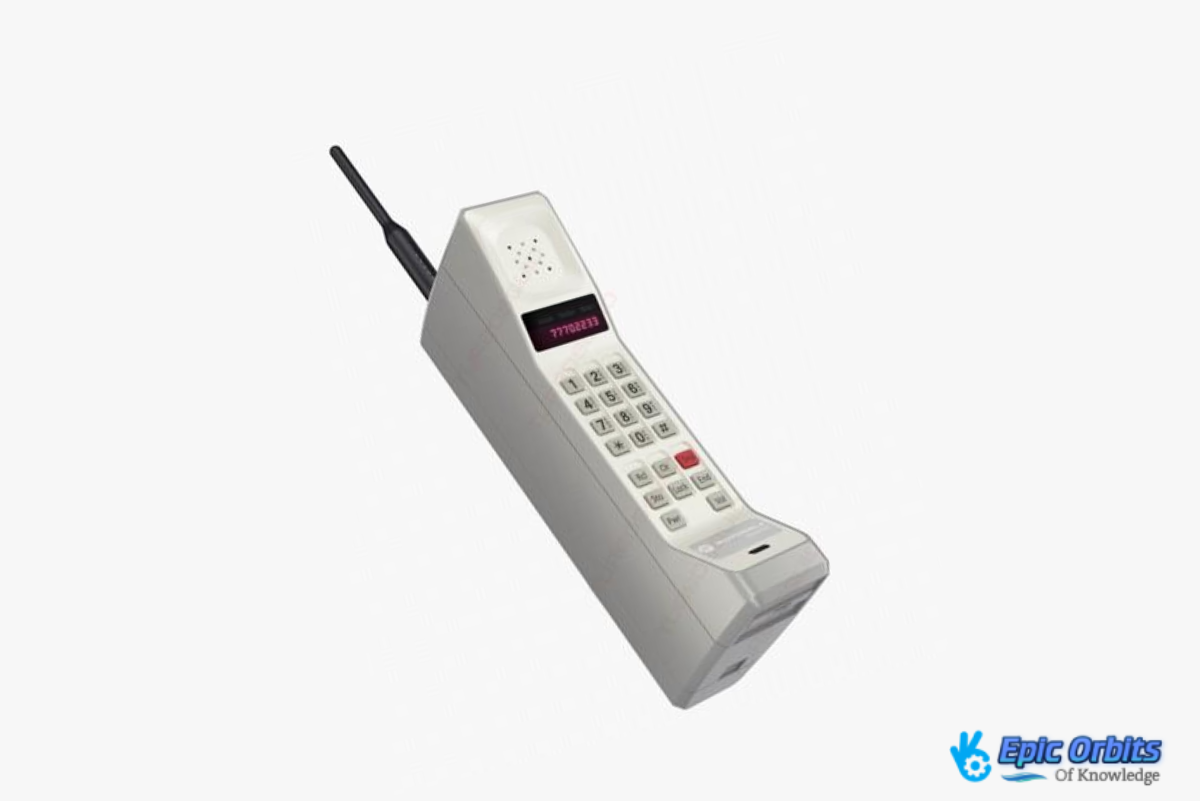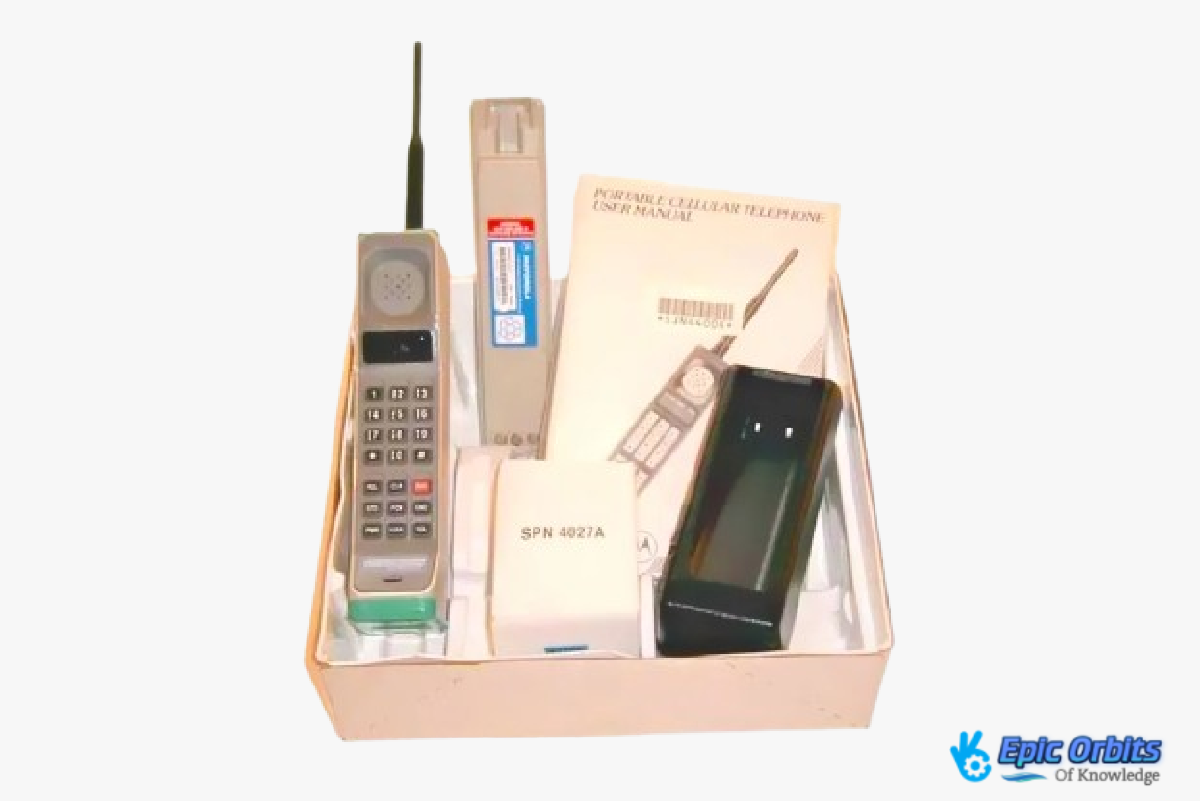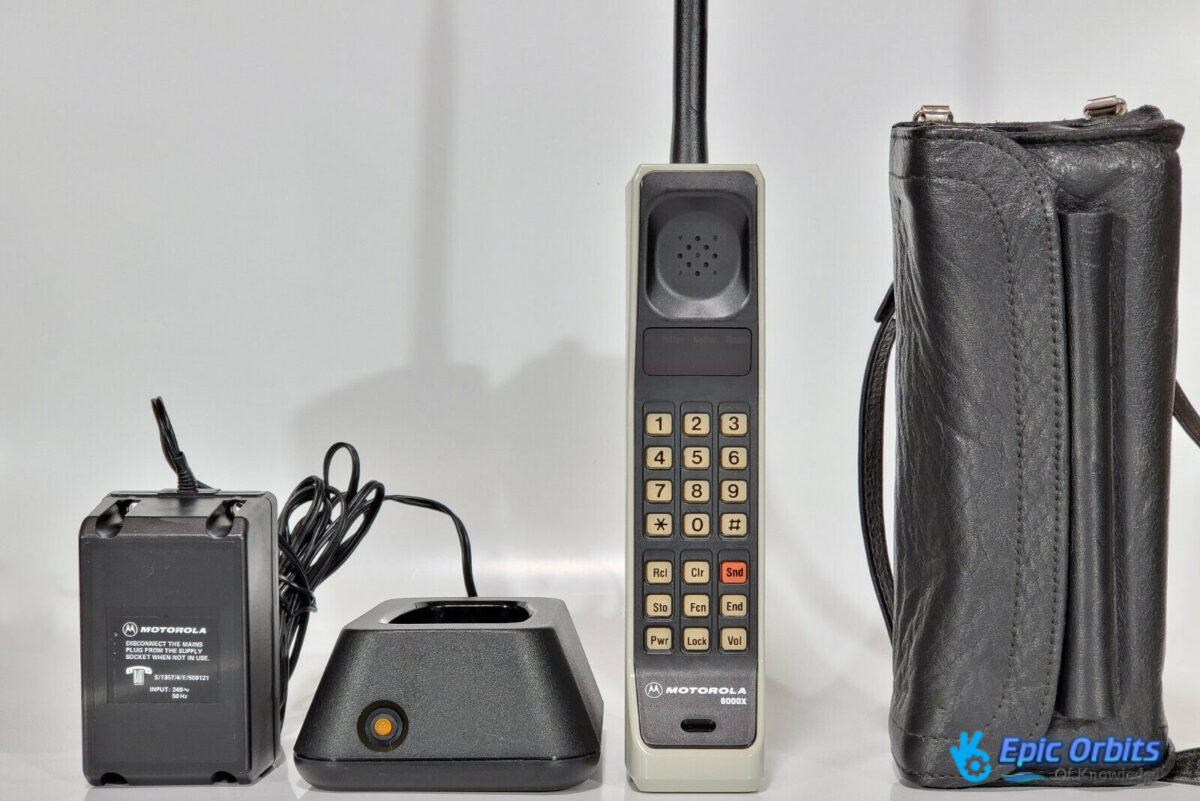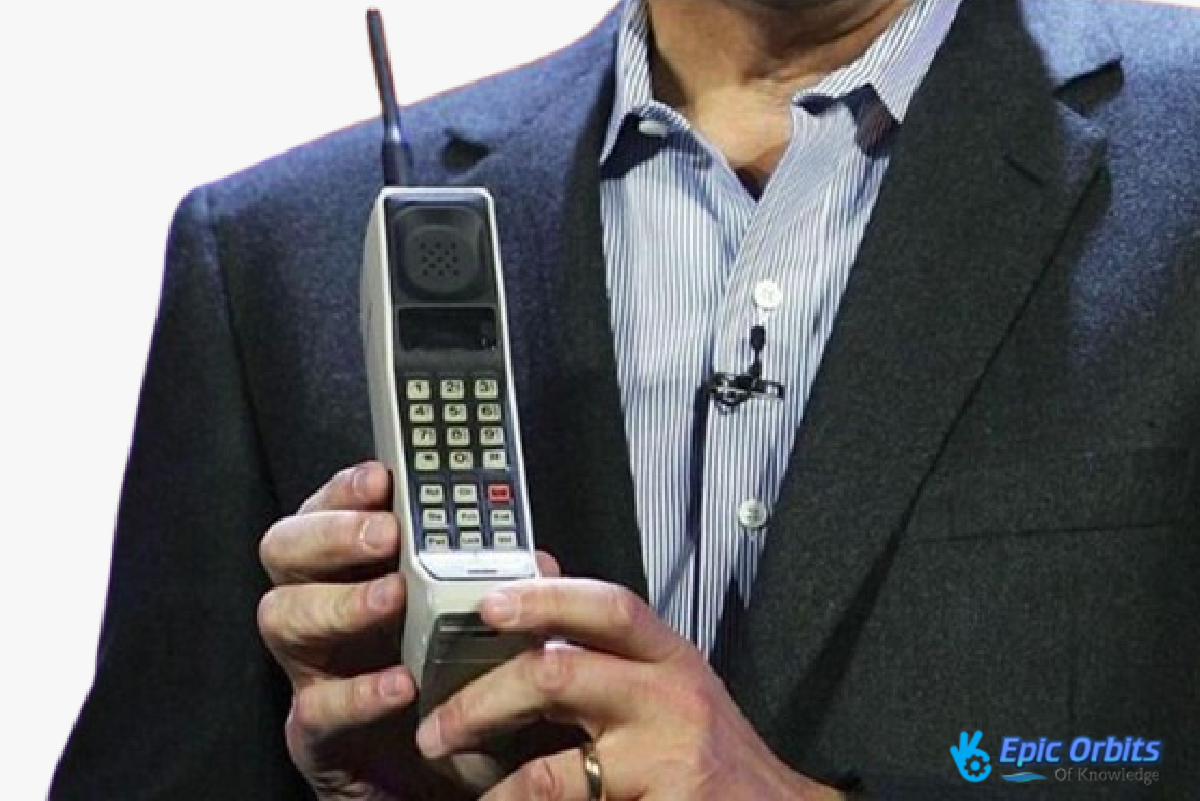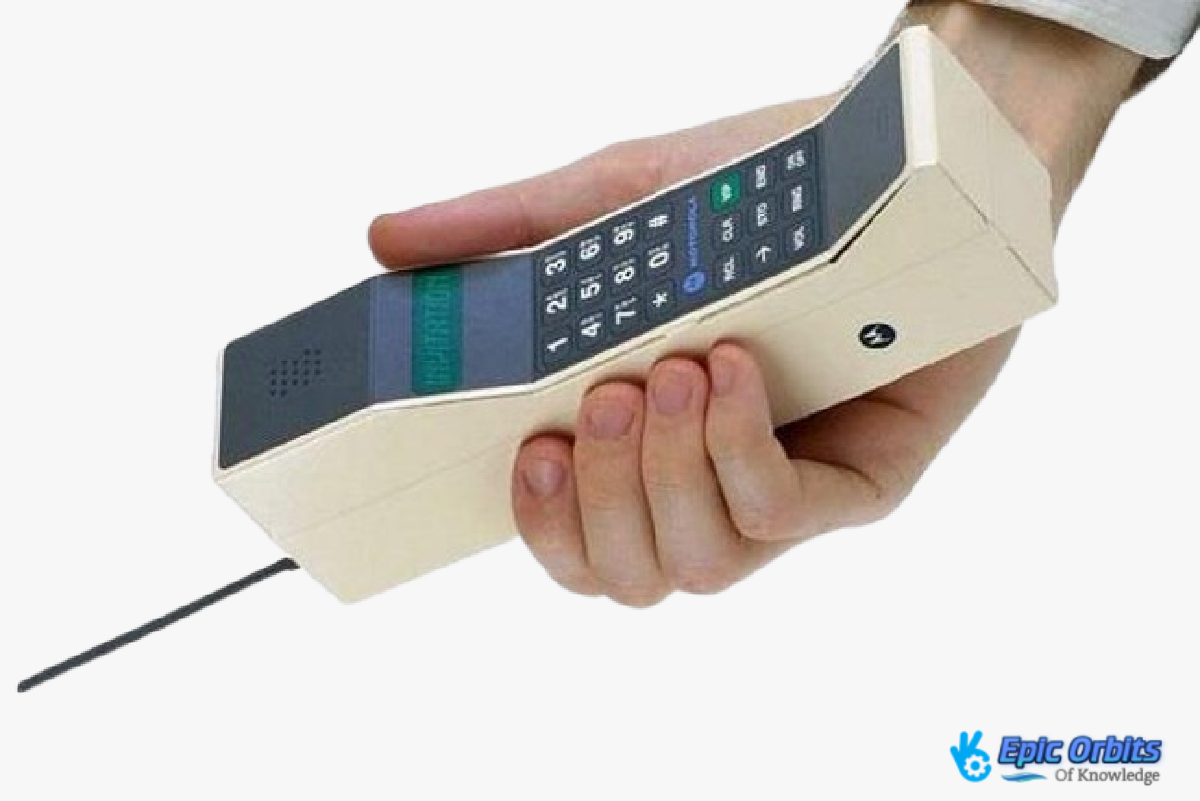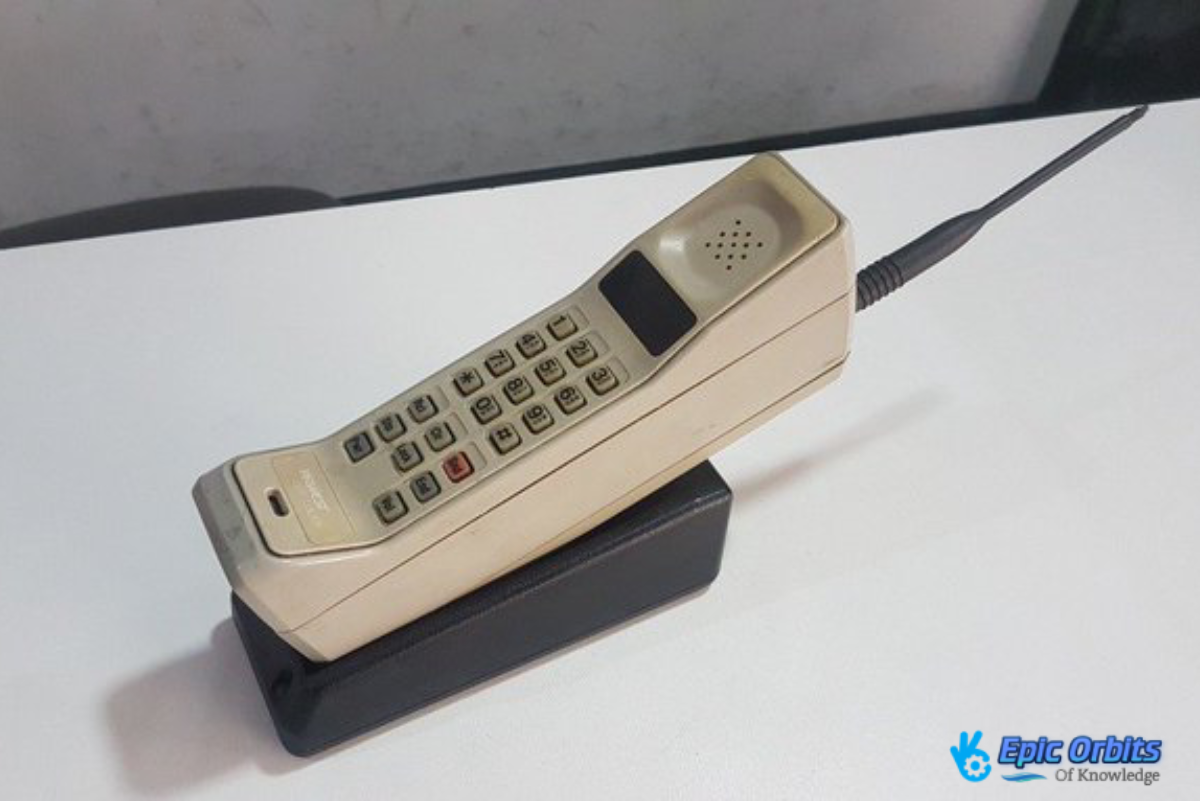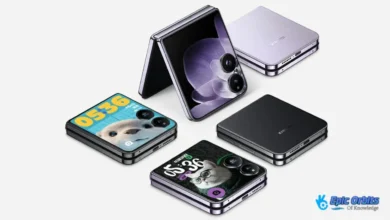The First Mobile Phone in History
Discover the story of the first mobile phone in history: who invented it, how it worked, and how it revolutionized global communications.
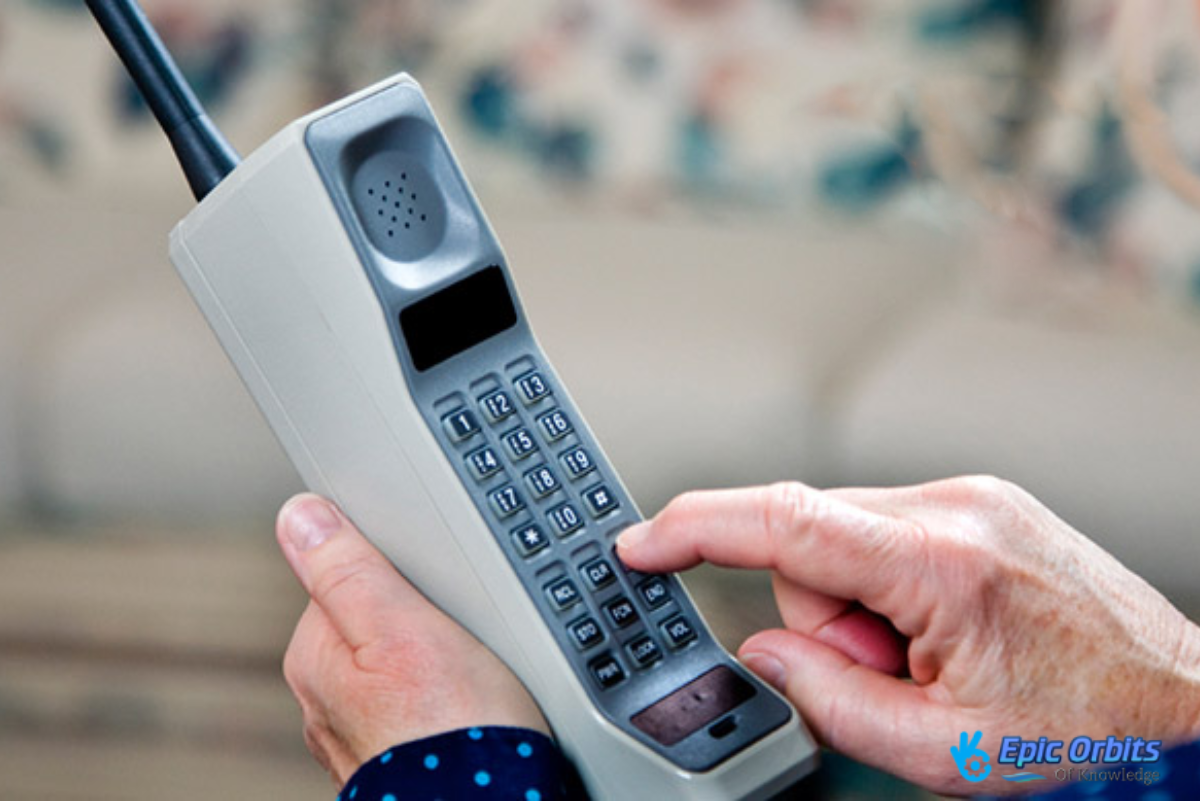
Martin Cooper, Motorola’s engineer, made a call on the first mobile phone, weighing more than two pounds, in 1973, permanently changing communication. The cell phone, a technology that would later revolutionize the globe, first emerged here.
Driven by constant innovation and a goal for a more linked society, the trip from those early brick-sized phones to today’s slimline smartphones has been nothing short of amazing.
This technology has transformed economies, changed social structures, and changed everyday practices all throughout the world; therefore, it transcends the domain of communication.
First Mobile Phone: The emergence of mobile communication
Over a century ago, when early pioneers began to bring the concept of mobile communication into reality, it was viewed as the realm of science fiction. Many trials and developments took place along the lengthy and meandering path to the contemporary mobile phone.
1. Early ideas and tests
Early in the 20th century, creators began looking into wireless communication’s prospects. One of the first known efforts at mobile communication, Professor Albert Jahn and the Oakland Transcontinental Aerial Telephone and Power Company claimed to have invented a wireless telephone in 1908. Decades ahead of its time, Finnish inventor Eric Tigerstedt later submitted a patent for a “pocket-size folding telephone with a very thin carbon microphone.”
Though typically simple and even unworkable, these early tests set the stage for the creation of cell phones. Starting in 1918, the German railroad system tested wireless telephones on military trains between Berlin and Zossen, therefore proving the possibility for mobile communication in transportation.
1. Pre-Cellular Radio Systems:
Modern mobile phones sprang from pre-cellular radio communication methods. These early systems, which were often heavy, required a significant amount of equipment to operate. Still, these were vital first steps toward the creation of cellular technology. Significant developments in radio communication after World War II opened a rich environment for the growth of mobile phones.
The viability of mobile communication grew along with technological advancement. Though large and not in the contemporary sense “mobile,” the early radiotelephone networks cleared the path for the mobile revolution. They proved that not only was wireless communication feasible but also maybe useful.
The Pursuit of Mobile Telephones
Following World War II, the scene was set for a worldwide contest to create a very portable phone, therefore ushering in a new phase in telecommunications. The globe was seeing a technological revolution, and the creation of portable phones turned into a main focus of invention.
1. After World War II: Developments
In the annals of mobile communication, 1946 was a momentous year. The year the first calls were made in Chicago on a vehicle radiotelephone But the service soon ran out of radio frequencies, therefore reaching capacity rapidly. This restriction underlined the necessity of more sophisticated technology to meet the rising demand for mobile communication.
Over the following ten years, mobile phone technology continued to evolve. Sweden had created the first automated mobile phone system for private cars by 1956. More like vehicle equipment than a portable phone, the gadget weighed a significant 40 kg and used vacuum tube technology with a rotary dial.
2. Phones for Cars: The Ancestral Agents
Although bulky by modern standards, early automobile phones laid the foundation for today’s mobile devices. They allowed users to make and receive calls on demand, representing a significant leap in telecommunications technology. Considering the technical limitations of the era, the ingenuity of these early systems is remarkable.
Key milestones include:
- 1946: The first car radiotelephone calls in Chicago, using radiotelephone technology (weight not specified).
- 1956: Sweden launched an automated mobile phone system utilizing vacuum tube technology with a rotary dial, weighing around 40 kg.
These early innovations addressed major technical challenges and set the stage for the development of portable mobile phones, with modern devices still tracing their roots back to these pioneering systems.
“The development of the mobile phone was a gradual process involving the contributions of many people and companies over several decades.”
Pushing the boundaries of what was deemed feasible was as important to the competition to produce portable phones as it was about technology. Looking back, we can appreciate the irony that these early “portable” phones were as hefty as a small refrigerator, but they were a necessary step toward the sleek, lightweight gadgets we use today.
Martin Cooper and the First Mobile Phone
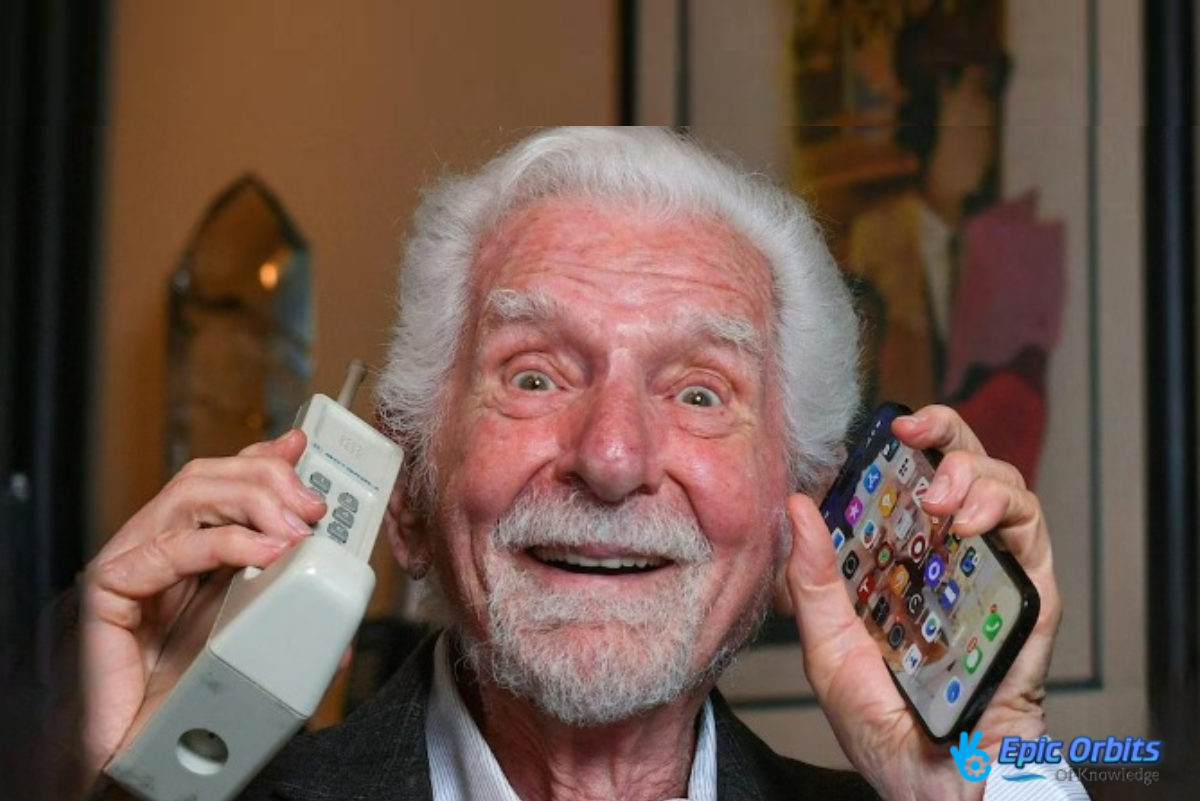
Martin Cooper answered a call on a momentous day in 1973 that would alter the planet forever. This event culminated years of research and development in mobile communication technology.
1. The Man Driving the Creativity
Motorola researcher and CEO Martin Cooper invented the first portable mobile phones. Cooper’s view of mobile communication transcended the tools at hand. In the early 1970s, his idea of a future when phones would be personal and portable was innovative.
Meet Martin Cooper, the person who permanently altered communication and most likely grew wonderful biceps from carrying the 2.2-pound “brick” he designed. The first portable phone resulted from Cooper’s creative energy and mobile communication concept.
2. The April 3, 1973, Historic First Call
Cooper made the first public call on a portable mobile phone on April 3, 1973, phoning his competitor, Bell Labs’s Dr. Joel S. Engel. Cooper utilized a 2 kg (4.4 lb) prototype portable phone that was 23 by 13 by 4.5 cm (9.1 by 5.1 by 1.8 in).
As Cooper made the first mobile phone call ever to his adversary at Bell Labs—the telecom equivalent of a mic drop— he savored the excellent business drama. Imagine the scene on April 3, 1973, when people stopped to admire somebody apparently chatting to a brick on a New York street; little did they realize they were seeing history.
The absurdity of the first mobile phone conversation lasting only seconds while the phone itself took 10 hours of charging for 30 minutes of talk time would cause current smartphone users to undergo a collective breakdown. Cooper envisioned a future when phones would be “so small that you could attach it to your wrist like a watch.” Smartwatch wearers may thank him today, as his vision transcended the technology of his time.
The DynaTAC 8000X: Technical Specifications
For its time, the first commercially sold mobile phone, the Motorola DynaTAC8000X, had remarkable technological capability. For the history of cellular communication, this gadget represented a major turning point.
1. Size, weight, and design
The DynaTAC 8000X, measuring 23 by 13 by 4.5 cm and weighing over 2.2 pounds, was truly a formidable device. The battery, which constituted a major part of the gadget, determined its weight and size most of all. With a numerical keypad and a display showing the phone number and a few other simple indications, the phone’s design was regarded as elegant for its time despite its weight.
Though carrying the phone around was still difficult, its “compact” measurements made it fairly portable. Early adopters often joked about the exercise they received from carrying about the DynaTAC 8000X, implying that a gym membership was superfluous.
2. Functionality and Battery Life
A major constraint of the DynaTAC 8000X was its short thirty-minute talk time. It was also less than convenient for regular usage, as charging took 10 hours. Notwithstanding these restrictions, consumer demand was high, and waiting lists in the thousands abounded.
Although the battery life was a significant issue, the device’s capabilities were groundbreaking for its time. Despite the tiny and restricted keypad, users were able to make and receive calls, although it was somewhat difficult.
A forerunner of later mobile phones, the DynaTAC 8000X was innovative. Though basic by today’s standards, its technological features were revolutionary in 1983.
First Mobile Phone: From Prototype to Commercial Product
From a prototype to a commercial product, the path of the first mobile phone was a ten-year adventure. It took more than ten years for the handheld mobile phone to be developed and introduced into the market after Martin Cooper’s first public call on one in 1973.
1. The 10-Year Development Trip
Developing the DynaTAC 8000X presented several difficulties. The first prototype had little use and was large. Motorola engineers dedicated significant effort over several years to perfecting the design, enhancing battery life, and improving overall performance. Perfecting a technology that, by today’s standards, would appear basic yet was innovative at the time depended on the tenacity of these engineers.
Overcoming several legal obstacles was a significant part of the development process and was as challenging as the technical tasks. The corporation had to negotiate difficult government rules and obtain licenses before commercially introducing the phone.
2. Market Launch 1983
On October 13, 1983, the DynaTAC 8000X was at last commercially launched in the Americas. With a price tag over $4,000, which is almost $11,000 now, it was sold as a status symbol. The phone’s novelty and the status connected with possessing such a gadget overwhelmed its weight and limited functioning.
Executives and wealthy individuals Consumers quickly purchased the gadget following the significant buzz generated by its market introduction. Although the gadget’s brick-like construction and limited features compared to current standards were noted, it was still regarded as a symbol of prosperity and technical expertise.
First Mobile Phone: The Revolution in Cellular Network Building
Modern cell phones originated with the 1947 hexagonal cell concept by Douglas H. Ring and W. Rae Young. While presenting at Bell Labs, Douglas H. Ring and W. Rae Young’s creative idea set the foundation for the cellular network technology that would ultimately transform mobile communication.
The simple but clever concept was to split a city into smaller, hexagonal cells so that frequencies could be effectively reused and mobile phone capacity increased. Martin Cooper would later show with the first handheld mobile phone call in 1973 that this idea was very essential for the evolution of useful mobile telephony.
1. Knowledge of Cellular Technology
Frequency reuse and handoff are among the few fundamental ideas guiding cellular technology. Frequency reuse significantly boosts the number of users a specific region can support by allowing multiple cells to utilize the same frequencies. Handoff is the technique of moving a call from one cell to another, ensuring a flawless conversation.
As it has been well said, “The cellular concept is a masterwork of efficiency, chopping up a city into hexagonal honeycombs of connectivity… This method has proven fundamental in enabling more than a handful of individuals to concurrently use their cell phones in the same city.
2. Initially, cellular networks were all around us.
Rising above the United States to the punch, Nippon Telegraph and Telephone (NTT) debuted the first cellular network in Japan in 1979 This event was a turning point in the development of mobile communication because it proved on a broad basis that cellular networks are feasible.
A major step toward the worldwide mobile phone service we use today was the opening of the first cellular network. It demonstrated how sophisticated technologies like handoff, frequency reuse, and cellular design might be used to provide the globe dependable and effective mobile phone service.
The irony that a 1940s idea took decades to come to pass emphasizes the intricacy and inventiveness needed in telecommunications. The backbone of our hyper-connected society today is cellular networks, which enable not just phone conversations but also a plethora of mobile services.
First Mobile Phone: The 1G Age Analog Origins
Modern mobile phones originated in the late 1970s and early 1980s when initial analog cellular networks started to take form. This period was the time of first-generation wireless technology, or 1G, which fundamentally changed public communication.
1. First Mobile Phone: AMPS and other first-generation systems
The first analog cellular system extensively used in North America was the Advanced Mobile Phone System (AMPS). It was started after the first installations of NTT’s system in Tokyo in 1979 and later releases in Nordic nations. Early 1G systems were notable for their use of frequency-division multiple access (FDMA) and need for large quantities of wireless spectrum.
Other nations built their own first-generation systems as well; examples of them include Comvik’s system in Sweden and NMT in Nordic nations. By increasing accessibility, these analog and quite crude devices by today’s standards transformed mobile communication.
2. Drawbacks of Early Mobile Technology
1G technology has various restrictions even if it had a revolutionary effect. Lack of encryption rendered calls susceptible to eavesdropping; the phenomenon of “cell phone cloning” became a major concern, causing fraudulent behavior and unanticipated user costs. Additionally bandwidth-intensive, the technology hampered capacity and efficiency.
Still, these early systems prepared the way for the later developments. The innovative work done in the 1G period made the transition from analog to digital—and finally to the sophisticated smartphones of today—feasible. The narrative of 1G reminds us that a vital first step towards innovation may involve significant technological restrictions.
2G Networks: The Digital Transformation
Driven by the GSM standard, the arrival of 2G technology in 1991 was more than simply an improvement; it was a whole transformation of the mobile communication scene. From the analog systems of the first generation (1G) to digital, the transition represented a major change accompanied by a number of new features and capabilities that would revolutionize human communication.
The advent of 2G networks sparked a standards battle between GSM (Global System for Mobile Communications) and CDMA (Code Division Multiple Access). While CDMA gained some traction in countries like the United States, GSM, developed in Europe, ultimately became the dominant global standard. This divergence led to compatibility issues, complicating international roaming.
- GSM: Predominantly used in Europe and globally, featuring digital signals and SMS capability.
- CDMA: Mainly deployed in the US, using a different approach for multiple access.
One of 2G’s most transformative innovations was SMS (Short Message Service). Initially designed as a network testing tool, text messaging quickly gained popularity, changing the way people communicate. It even gave rise to a new digital shorthand, with abbreviations like “C U L8R” entering everyday use.
2G networks had a significant effect on mobile phones, turning them from basic means for voice and data transfer into simple communication tools. The basis created by 2G will open the path for further developments as the telecom sector keeps changing.
Cellphones Go Mainstream
The late 1990s marked a significant shift as cell phones began to penetrate the public sphere. The outcome was a cultural change rather than just a question of increased phone sales. Mobile phones were becoming a basic need for the average people, not just for corporate professionals.
One cannot exaggerate Nokia’s influence on the mobile phone market. Not only were their phones feature-rich, but they also were very robust, giving them the moniker “indestructible.” Nokia’s success was a major contributor to the general acceptance of mobile phones, thereby arming billions of consumers all over.
The general acceptance of cell phones brought about notable shifts in customer behavior. The UK alone had more mobile phones than homes by 1999, showing the quick acceptance speed. New social behaviors include the phenomenon of “phantom vibration syndrome,” where users mistakenly believe their phone is vibrating, a condition that arose as cell phones became more widespread. Constant communication also altered; “I’ll call you later” became an instant expectation instead of a nebulous promise.
It is difficult to picture a society devoid of mobile phones nowadays. Over 90% of people in approximately half the nations on the globe possess at least one mobile phone, which is a basic need for contemporary living. From a status symbol to a need, the cell phone has revolutionized our communication and interaction with the surroundings.
Starting the Smartphone Revolution
A groundbreaking gadget that permanently altered the mobile scene defined the advent of the smartphone age. The device was the result of years of inventiveness, not an instant phenomenon. A turning point came with the release of the iPhone in 2007; the first Android phone arrived in 2008.
Smartphones, before the iPhone, were clumsy tools with limited capability that needed styluses. The current cellphones we know of originated in these early efforts. They set the foundation for the next developments.
Launched in 2007, the iPhone cost $499—a large sum for a phone in those days. Although it was initially met with mistrust, especially from Nokia’s CEO, who dismissed the iPhone as merely a “cool phone,” the device ultimately transformed the smartphone industry. It persuaded millions that a phone devoid of a physical keyboard was not only practical but also appealing.
The launch of the T-Mobile G1 in 2008, running Android 1.0, followed the iPhone’s 2007 debut, sparking the smartphone wars that continue to shape the industry. The competition between iOS and Android has since become a defining feature of the mobile sector.
Key comparisons at launch:
- Operating System: iPhone used iOS, while the T-Mobile G1 ran Android 1.0.
- Display: TiPhone featured a 3.5-inch touchscreen, compared to the G1’s 3.2-inch touchscreen.
- Price: iPhone launched at $499, whereas the G1 was priced at $179 with contract.
The smartphone revolution profoundly transformed communication, information access, and mobile usage, reshaping the cell phone market and leaving a lasting impact on society and technology.
First Mobile Phone: From 3G to 5G The Data Evolution
With 3G, 4G, and now 5G redefining what’s possible, mobile data has moved from a curiosity to a need in the course of a few years. Mobile internet connectivity began with the release of 3G in Japan by NTT DoCoMo in 2001, but it was just the beginning of a voyage wherein data speeds would rise dramatically.
1. Empowering Mobile Internet
Despite its limited capacity, the launch of 3G enabled the first true mobile internet experience. It was abundantly evident by 2009 that the rising demand for bandwidth-intensive uses like streaming movies would soon surpass 3G. This insight caused the sector to turn toward 4G technology, which promised significant speed increases.
Mobile internet evolved as 4G went out to enable more consumers and more demanding services. Starting globally in 2019, the move to 5G has hastened this trend by providing even higher data speeds and reduced latency.
2. Enhancements in speed and connectivity
Between 3G and 5G, the developments have been absolutely revolutionary. We were in awe of our phones’ email-checking capability, but now we anticipate flawless, high-quality video streaming. The irony is that, as our networks became faster, our tolerance for delays decreased, making the spinning loading indicator a modern annoyance.
- From barely running a basic website on 3G to downloading massive quantities of data in seconds with 5G, the development has seen internet rates substantially increase.
- From celebrating a song download in less than ten minutes, our expectations have changed to wanting instantaneous access to whole seasons of TV series.
- Mobile data is now frequently faster than residential internet connections, as the technical leapfrogging has been so quick.
How the first mobile phone transformed society
The first mobile phone transformed communication, therefore changing society’s expectations and behavior. Considered among the most significant human creations, mobile phones are among the most often used and sold items of consumer technology.
The arrival of mobile phones started a social revolution that profoundly changed our interaction. After stating, “I’ll call you when I get home,” we started to question, “Why aren’t you responding to my SMS right now?” I can see you are online. New social conventions resulting from this change include the often difficult choice between phoning or texting someone.
Mobile phones have fundamentally altered communication styles. Being always connected has turned into a two-edged blade, providing unmatched ease but also bringing new fears, such as the anxiety of seeing “…” show and then vanish on a messaging app. From CEOs to kids, the democratization of communication has given everyone, anywhere and anytime, access.
This continuous connectedness has changed our expectations and actions, making constant availability a social convention. The effects on both personal and professional interactions have been significant, thereby influencing our everyday activities and connection maintenance.
The first mobile phone also set off an economic revolution, creating sectors not seen before and changing company processes. There have been far-reaching effects from the change from a 9-to-5 work culture to a 24-hour, always-on one. Companies may now run around the clock, and many monitor emails at all hours, so the expectation for quick replies has become the standard.
Along with altering company behavior, this metamorphosis has created fresh chances for economic development and expansion. The mobile phone sector itself has grown to be crucial, as it stimulates global employment and invention.
The First Mobile Phone’s Legacy in Current Technology
Not only did the first mobile phone leave a historical footnote, but it also had a significant impact on contemporary technology. Looking at our modern cellphones, it’s shocking to realize that the basic issue they address still existed decades ago: allowing people to interact free from physical location constraints.
“The future is not something we enter, but something we create,” says the author; the development of the first mobile phone prepared the ground for the technological wonders we know today. Though its brick-like appearance seems archaic in comparison to modern gadgets, the DynaTAC reflected a groundbreaking concept that has only developed in form rather than use.
1. First Mobile Phone: Design Ideas That Still Apply Now
Even with the significant advancements in technology, some design concepts from the first mobile phone have endured. For example, the revolutionary idea of portability has been driving industrial innovation since then. Though far more advanced, modern cellphones still give top priority to being small and easy to use.
The original mobile phone’s emphasis on releasing users from set places has developed into the mobile-first strategy of today’s tech sector.
Areas of ongoing study and development still focus on early mobile phone restrictions, such as battery life.
2. First Mobile Phone: Teachings for Contemporary Innovation
The history of the first mobile phone reminds us that real disruption comes from drastically reevaluating what is feasible rather than making little changes. Knowing the legacy of the first mobile phone will help us to better appreciate the need for invention and the need to always stretch beyond the limits of what is considered feasible as we look forward at the direction of mobile technology.
As Martin Cooper, the person behind the first mobile phone call, once underlined the importance of his creation, it becomes evident that the influence of the first mobile phone goes far beyond its physical appearance and shapes the fundamental way we use technology nowadays.
First Mobile Phone: Mobile Technology’s Future Directions
We are on the verge of entering a new era in which cellphones may become relics of the past due to the rapid evolution of mobile technology. Mobile phones’ future is about transforming our interaction with technology, not just about little improvements.
Our tools of choice are about to undergo a major metamorphosis. Our present cellphones appear archaic by contrast as we go into a time where technology is increasingly entwined into our everyday lives.
It is becoming more and more likely that the current version of cellphones will vanish. Wearables, implantables, and ambient computing are probably here to replace today’s “cutting-edge” equipment.
- The growth of wearables might mean that our phones become an item we seldom use.
- From a deliberate activity to a seamless part of our surroundings, implantables and ambient computing might change our engagement with technology.
Technologies set to revolutionize our interaction with mobile technology include augmented reality, neural interfaces, and ambient computing. These developments could replace the actual smartphone with a more responsive, intuitive environment, therefore rendering the device extinct.
We are amazed at how quickly we adapted to mobile technology, and even more amazing developments are coming. The ultimate legacy of the cell phone might be its obsolescence as communication technology permeates our lives and we no longer require a specific gadget.
Conclusion
The first mobile phone’s development signaled a change in human communication. Originally a large prototype in the hands of Martin Cooper, what started out as such turned into the basis for a worldwide technological revolution.
Though it seems archaic by today’s standards, the Motorola DynaTAC 8000X helped create cellphones that now link billions of people worldwide. Knowing the background of mobile technolIt emphasizes our progress and reminds us of how creativity can change daily life.
